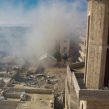
Experts in Russia Say Moscow Should Heed Lessons from Wars in Syria, Libya and Yugoslavia
Publication: Eurasia Daily Monitor Volume: 10 Issue: 101
By:

On April 26, the authoritative Russian newspaper Nezavisimaya Gazeta hosted a roundtable of experts on the situation in Syria. Although almost all the experts, as usual, accused the United States and the West of fueling civil unrest in Syria now and Libya and Yugoslavia in the past, some of them also noted that internal issues in each of these countries were the primary cause of the wars there. According to these experts, Russia should learn how to fight the new type of wars; have a pragmatic, self-interested relationship with the West; strengthen Russia’s political system; and improve its demographic makeup. “It is naïve to accuse the West of all of our problems and difficulties, first of all we should demand answers from ourselves,” said Yuri Baluevsky, who served as chief of the General Staff of the Russian Armed Forces from 2004 to 2008 (https://nvo.ng.ru/polemic/2013-05-24/1_siria.html).
Another military expert, Colonel Igor Strelkov, asked whether Russia is “ripe” for experiencing events like those in Syria on its own territory. The expert noted that in Syria, 80 percent of the population is Sunni and 10 percent has other religious affiliations, while only 10 percent of the population belongs to the ruling Alawite group, so the country was inherently prone to an outbreak. The same demographic weakness was apparent in Libya, where the ruling tribes comprised about 10 percent of the country’s population. In Yugoslavia, the Serbs were also in demographic decline, which, in Strelkov’s view, made the country vulnerable to external invasion. The expert sounded the alarm that Russia is headed down the same road that Yugoslavia went down earlier, as “[t]here is a powerful process of displacement of ethnic Russians from the territories of the [North] Caucasus, the Volga region and Tuva. In some areas this process has been completed.” He said that while ethnic Russians used to comprise 33 percent of Tuva’s population, today it is only 8 percent (https://nvo.ng.ru/polemic/2013-05-24/1_siria.html).
A decrease in the number of ethnic Russians in the North Caucasus has been evident for the past several decades. The so-called titular ethnic groups started to increase their share of the total population at the expense of ethnic Russians long before the Soviet Union’s demise in 1991. The 2010 census found that ethnic Russians constituted only 3.6 percent of Dagestan’s population, down from 9.2 percent found in the 1989 census. The proportion of ethnic Russians in Dagestan’s population reached its highpoint in 1959, when they comprised just over 20 percent of the total republican population. The next Soviet census, conducted in 1970, found that the share of ethnic Russians in Dagestan’s population fell to 14.7 percent.
Ethnic Russians comprised nearly 25 percent of Chechnya’s population at the time of the 1989 census, but their share had fallen to less than 2 percent by 2010. In Ingushetia, ethnic Russians made up 13.2 percent of the republican population that fell to under 1 percent in 2010. In North Ossetia, the share of ethnic Russians in the republican population fell from 30 percent in 1989 to 20.6 percent in 2010. The population of ethnic Russians in Kabardino-Balkaria decreased from 32 percent in 1989 to 21.5 percent in 2010. In Karachaevo-Cherkessia, in 1989, ethnic Russians made up 42.4 percent of the total population and were the largest ethnic group in the republic, which at that time was part of the large Russian-speaking Stavropol region. In 2010, ethnic Russians made up only 31.4 percent of Karachaevo-Cherkessia’s total population, while indigenous Karachays were the largest single group, accounting for 40.7 percent of the total republican population. Even in Adygea, which has had a Russian majority for a long time, the share of ethnic Russians in the total republican population still decreased from 68 percent in 1989 to 61.5 percent in 2010 (Russian state statistical service, 2010 Russian census results).
“As soon as an economic crisis strikes, war will start [in Russia]. If we do not draw the right conclusions, we will arrive at the same end result as [Bashir al-]Assad, [Muammar] Qaddafi and [Slobodan] Milosevic,” Colonel Strelkov warned. The expert emphasized that reversing the changes in the ethnic makeup of Russia was the key to the country’s survival. Migration of non-Russians from CIS countries was also one of the major security dangers, according to Strelkov (https://nvo.ng.ru/polemic/2013-05-24/1_siria.html).
At the same time, however, Russian authorities also appear to be worried about migration from other countries in the Commonwealth of Independent States (CIS). Moscow has resisted calls to introduce a visa regime for those coming from CIS countries, but from January 2015 on, citizens of the CIS will be required to have foreign passports to travel to Russia. The Russian Migration Agency estimates that every year 11–14 million migrants come to Russia in search of work. Twenty percent of these migrants come from Ukraine, 15 percent from Uzbekistan and 11 percent from Kazakhstan. The World Bank estimates that 12.5 million migrants come to Russia every year. Thirty-five percent of all the migrants remain in Moscow and the Moscow region, so it is not a surprise that the Moscow city administration is spearheading the effort to prevent the inflow of migrants (https://www.kommersant.ru/doc/2194515).
The desire to impose restrictions on migration from CIS countries comes into contradiction with the geopolitical ambitions of the Kremlin, which is trying to recreate something similar to the Soviet Union. At a time when even the Russian Federation is becoming increasingly fragmented in ethnic and religious terms, reminiscent of the developments in the Balkans prior to the war in Yugoslavia, Moscow’s ambitions are likely to be trimmed by rising ethnic Russian resentment.




